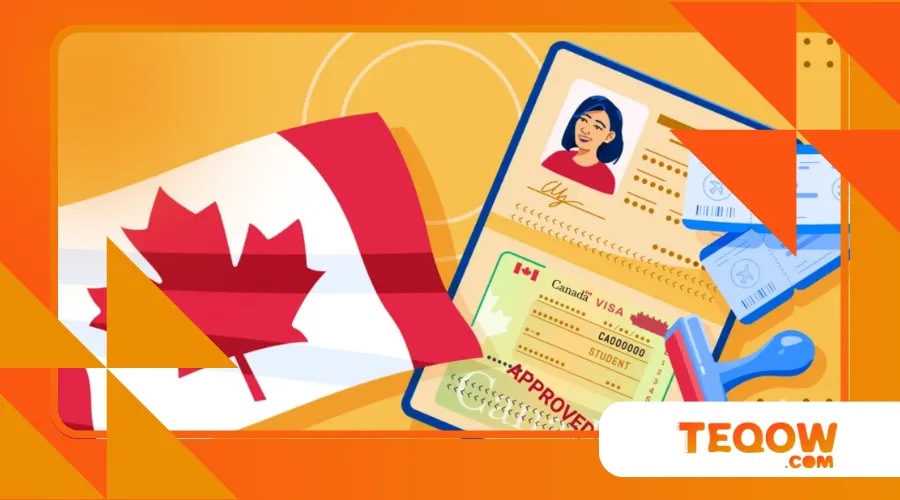How to Get a Student Visa for Canada: Everything You Need to Know

Knowing how to get a student visa for Canada is your first step toward turning that dream into reality.
Canada’s vibrant academic environment, diverse culture, and post-graduation work opportunities attract thousands of international students annually.
According to Immigration, Refugees and Citizenship Canada (IRCC), over 800,000 international students held study permits in 2023, a testament to Canada’s global appeal.
However, securing a study permit requires careful planning, precise documentation, and a clear understanding of the process.
This guide breaks down everything you need to know, offering actionable insights, creative strategies, and up-to-date information to help you navigate the journey with confidence.
Why Study in Canada? The Big Picture
Canada’s education system ranks among the best globally, with institutions like the University of Toronto and McGill University consistently appearing in top-tier rankings.
Beyond academics, the country offers a safe, multicultural environment and pathways to permanent residency through programs like the Post-Graduation Work Permit (PGWP).
But why does this matter? A student visa isn’t just a bureaucratic hurdle—it’s your gateway to these opportunities.
Think of it like a key to a treasure chest: without it, the riches of Canadian education and career prospects remain locked away.
In addition to its academic strengths, Canada is known for its high quality of life and welcoming attitude towards international students.
This makes it an attractive destination for those looking to broaden their horizons while receiving a top-notch education.
Step 1: Secure Admission to a Designated Learning Institution (DLI)
Before applying for a study permit, you must be accepted into a Designated Learning Institution (DLI), a school approved by the Canadian government to host international students.
Not all schools qualify, so verify your institution’s status on the IRCC website.
Example: Maria’s Journey
Maria, a 22-year-old from Brazil, dreamed of studying environmental science at the University of British Columbia (UBC).
She researched UBC’s DLI status, applied early, and tailored her application to highlight her passion for sustainability.
Her acceptance letter arrived within two months, giving her ample time to prepare her visa application.
Pro Tip: Apply to multiple DLIs to increase your chances.
Each acceptance letter strengthens your case, showing flexibility and commitment.
| Key DLIs in Canada | Location | Notable Programs |
|---|---|---|
| University of Toronto | Toronto, ON | Engineering, Business |
| McGill University | Montreal, QC | Medicine, Law |
| UBC | Vancouver, BC | Environmental Science |
Additionally, researching the programs offered by different DLIs can help you choose the best fit for your career goals.
Consider factors like faculty expertise, campus facilities, and student support services to make an informed decision.
Step 2: Gather Essential Documents
The IRCC requires a comprehensive set of documents to assess your application.
These include:
- Acceptance Letter: Proof of admission from a DLI.
- Proof of Funds: Evidence you can cover tuition, living expenses, and return transportation. For 2025, IRCC requires at least CAD 20,635 for living costs (excluding tuition) for a single applicant.
- Passport: Valid for the duration of your stay.
- Statement of Purpose (SOP): A compelling letter explaining why you chose Canada, your study plans, and ties to your home country.
- Biometrics: Fingerprints and a photo, typically required for most applicants.
- Medical Exam: Mandatory for stays over six months, depending on your country of origin.
Crafting a standout SOP is crucial.
Avoid generic templates—IRCC officers can spot them instantly.
Instead, weave a narrative that connects your academic goals to Canada’s offerings.
For instance, if you’re studying AI, mention Canada’s leadership in tech hubs like Toronto and Montreal.
Example: Ahmed’s SOP Success
Ahmed, an engineering student from Egypt, wrote an SOP linking his robotics passion to Canada’s thriving tech ecosystem.
He referenced specific professors at the University of Waterloo and outlined how his studies would contribute to Egypt’s tech sector upon return.
His application was approved in three weeks.
Moreover, be sure to keep all documents organized and easily accessible during the application process.
This will help you avoid any last-minute complications and ensure a smooth submission.

Step 3: Apply for Your Study Permit
Once you have your documents, it’s time to apply for your study permit.
Most applicants use the IRCC’s online portal for faster processing.
The application fee is CAD 150, and processing times vary by country—check the IRCC website for current estimates.
To get a student visa for Canada, ensure every detail is accurate; even minor errors can lead to delays.
Application Checklist
| Document | Purpose | Tips |
|---|---|---|
| Acceptance Letter | Confirms DLI admission | Double-check DLI status |
| Proof of Funds | Shows financial capability | Include bank statements, scholarships |
| Statement of Purpose | Explains intent and ties to home | Be authentic, avoid clichés |
Statistic: In 2023, IRCC reported a 60% approval rate for study permit applications, underscoring the importance of a strong, error-free submission.
It’s also advisable to keep copies of all submitted documents for your records.
This can be helpful if you need to refer back to them during the application process or in future interactions with IRCC.
Step 4: Prove Financial Stability
Financial proof is a cornerstone of your application.
Canada wants assurance you won’t face financial hardship while studying.
Beyond the CAD 20,635 minimum, you’ll need to show tuition payment or a Guaranteed Investment Certificate (GIC).
Some countries, like India, benefit from the Student Direct Stream (SDS), which fast-tracks applications for those with a GIC and upfront tuition payment.
Analogy: Think of your financial proof as a bridge.
It connects your aspirations to reality, showing IRCC you’re ready to cross into Canada’s academic landscape without stumbling.
Additionally, consider creating a detailed budget plan that outlines all expected expenses during your studies.
This can help you better understand your financial needs and ensure you meet the IRCC’s requirements.
Step 5: Navigate Biometrics and Medical Exams
Biometrics are mandatory for most applicants aged 14–79, costing CAD 85.
You’ll need to visit a Visa Application Centre (VAC) for this step.
Medical exams, if required, must be conducted by an IRCC-approved panel physician.
Plan these early to avoid delays.
Rhetorical Question: Why risk a last-minute scramble when a little foresight can streamline your path to studying in Canada?
It’s also beneficial to check the processing times for biometrics and medical exams to ensure you complete these steps well ahead of your application deadline.
Staying organized will help you manage your timeline effectively.

Step 6: Prepare for the Interview (If Required)
While not common, IRCC may request an interview to verify your intent.
Be ready to discuss your study plans, financial resources, and ties to your home country.
Practice concise, confident answers to demonstrate genuine interest.
Additionally, researching common interview questions can help you prepare effectively.
Consider conducting mock interviews with friends or family to build your confidence and improve your delivery.
++ How Artificial Intelligence Is Transforming Canadian Classrooms in 2025
Step 7: Await Approval and Plan Your Arrival
Once approved, you’ll receive a Port of Entry (POE) Letter of Introduction.
This isn’t your study permit—your actual permit is issued when you enter Canada.
At the border, present your POE letter, passport, and proof of funds.
To get a student visa for Canada, ensure all documents are accessible.
Post-Arrival Tips
- Work Eligibility: With a study permit, you can work up to 20 hours per week off-campus during academic sessions.
- Health Insurance: Most provinces require international students to enroll in health plans—check your DLI’s requirements.
- Stay Compliant: Adhere to permit conditions, like maintaining full-time enrollment, to avoid issues.
Once you arrive, take the time to familiarize yourself with the local culture and resources available to international students.
This can enhance your experience and help you adjust more quickly to your new environment.
Common Pitfalls and How to Avoid Them
Navigating the study permit process isn’t without challenges.
Here are three common mistakes and solutions:
- Incomplete Applications: Missing documents lead to rejections. Use a checklist and double-check submissions.
- Weak SOPs: Generic letters fail to impress. Personalize your SOP with specific goals and connections to Canada.
- Insufficient Funds: Underestimating costs can derail your application. Budget for tuition, living expenses, and emergencies.
To further enhance your application, consider seeking feedback from peers or mentors who have successfully navigated the process.
Their insights can help you refine your approach and avoid common pitfalls.
The Student Direct Stream (SDS): A Faster Option
For eligible countries like India, China, and the Philippines, the SDS offers expedited processing—often within 20 days.
Requirements include a GIC, upfront tuition payment, and language test results (e.g., IELTS with a minimum score of 6.0).
If you qualify, SDS can significantly speed up your journey to get a student visa for Canada.
Moreover, staying informed about any changes to the SDS requirements can help you better prepare your application.
Check the IRCC website regularly for updates and announcements.
Why Preparation Matters
A well-prepared application isn’t just about ticking boxes—it’s about telling a story.
IRCC officers want to see a clear, logical path from your current situation to your Canadian education and beyond.
By anticipating requirements, addressing potential red flags, and presenting a cohesive case, you increase your chances of success.
Additionally, engaging with current international students or alumni can provide valuable perspectives and tips on how to strengthen your application.
Their experiences can offer insights that you may not find in official resources.
As you embark on this journey, remember to take advantage of resources like the official Government of Canada website for the most accurate and up-to-date information.
Final Thoughts: Your Canadian Adventure Awaits
Securing a study permit is a pivotal step toward studying in Canada, a country renowned for its academic excellence and welcoming culture.
By following these steps—securing DLI admission, gathering documents, proving financial stability, and submitting a flawless application—you’ll be well on your way to achieving your educational goals.
The process to get a student visa for Canada may seem daunting, but with strategy and persistence, it’s entirely achievable.
Start early, stay organized, and let your passion for learning shine through.
Your Canadian adventure is closer than you think.
This will ensure you have the latest guidelines and support as you navigate your path to studying in Canada.
